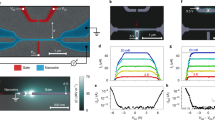Abstract
The incoherent transport model based on electron-phonon interaction was introduced for calculating the current-voltage characteristics of the nanowire conductor. The current-voltage characteristics of silicon nanowire calculated based on this model was discussed. The charge transport was described by the rate equation containing the coherent (tunneling) and incoherent (energy dissipation) rates, and the incoherent rate was calculated from the Hamiltonian in which the electron-phonon interaction was incorporated. The coherent transition corresponds to the electronic transition between electrode states and channel states without any energy dissipation. On the other hand, the incoherent transition corresponds to the electronic transition between electrode states and channel states where the energy difference of those two states means a thermal dissipation. Therefore, in order to carry out the calculation by the rate equation, the density of states (DOSs) of the carriers in electrode and the channel and the DOS of the phonon in the channel are needed. The current-voltage characteristics were calculated by using the DOS of n-type semiconductor for the electrode and by using intrinsic semiconductor DOS for the channel. In addition, the calculation was performed by using the DOS of the silicon nanowire phonon.
Similar content being viewed by others
References
Y. Zhang, J. X. Cao, Y. **ao, and X. H. Yan, J. App. Phys. 102, 104303 (2007).
K. Likharev, “Sub-20 nm Electron Device,” Advanced Semiconductor and Organic Nano-techniques, ed. Hadis Morkos (Academic Press, 2003), pp. 237–302.
ITRS 2009 International Technology Roadmap for Semiconductors.
Sang-Kwon Lee, Seung-Yong Lee, Konstantinos Rogdakis, Chan-Oh Jang, Dong-Joo Kim, Edwige Bano, and Konstantinos Zekentes, Solid State Communications, 149, 461 (2009)
Zhaohui Zhong, Chen Yang, and Charles M. Lieber, “Silicon Nanowires and Nanowire Hetero structures” Nanosilicon, ed. Vijay Kumar (Elsevier, 2008), pp. 176–216.
Abhishek Kumar Singh, Vijay Kumar, and Yoshiyuki Kawazoe, “Theoretical Advances in the Electronic and Atomic Structures of Silicon Nanotubes and Nanowires” Nanosilicon, ed. Vijay Kumar (Elsevier, 2008), pp. 217–257.
Kofi W. Adu, Humberto R. Gutierrez, and Peter C. Eklund, “Phonons in Silicon Nanowires” Nanosilicon, ed. Vijay Kumar (Elsevier, 2008), pp. 259–288.
Robert Zwanzig, Nonequilibrium statistical mechanics, (Oxford, 2001), pp. 106–110.
Inna Ponomareva, Madhu Menon, Ernst Richter, and Antonis N. Andriotis, Phys. Rev. B74, 125311 (2006).
Author information
Authors and Affiliations
Rights and permissions
About this article
Cite this article
Nishizawa, H., Itoh, S. Incoherent Transport in Nanowire - The Effect of Electron-phonon Interaction. MRS Online Proceedings Library 1206, 5 (2009). https://doi.org/10.1557/PROC-1206-M11-61
Received:
Accepted:
Published:
DOI: https://doi.org/10.1557/PROC-1206-M11-61




